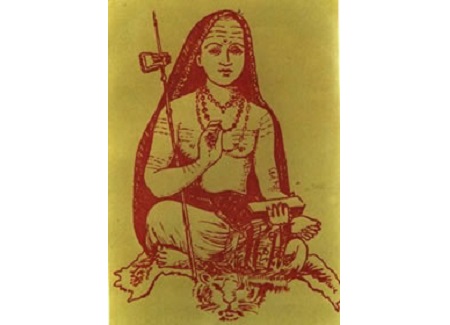
Dakshinamurti Stotra
Dakshinamurti Stotra
(transcribed, edited, and amended from a lecture
celebrating Guru-purnima at
The Meditation Center Minneapolis, USA)
by Swami Veda Bharati
There is a book: Dakshinamurti Stotra. It is only ten verses, composed by the great Shankaracharya. They are a hymn in the honour of God as teacher, who is often shown in iconography in a beautiful forest, for the great ancient ashrams were in forests, filled with the sounds of birds and animals. At such a place, where the beasts of prey have ceased all violence, he is pictured as sitting under a great sheltering banyan tree, that sends down branches as shoots that become roots and the tree expands.
Under such a banyan tree Dakshinamurti, but a youth, sits in silence, surrounded by elderly-looking disciples; his silence is his speech, and all the disciples’ questions are answered. All their doubts vanish.
It is not a book for reading; it is for studying and for long contemplation. Here now we take ourselves away from the respect for ordinary sources of knowledge, to transcend it so that one may sit face-to-face with God the Teacher, the Guru, whose silence is his sermon.
It is not possible to translate verbatim such multi-layer language in simple sentences. So I present an augmented paraphrase to catch some part of the inner meaning. But, in order to truly understand, wait for the time when you can contemplate these over a long period in silence.
The commentator introduces the first verse by saying, “There is no greater gain than gaining the knowledge of one’s own Spiritual Self. There is no greater gain than knowing the Self.” So have the sages known in all the traditions. Therefore, seeking such a supreme benefit, the composer offers praises to the Supreme Being who is our own very Self, the One who by freedom of His will has created the whole universe, and having created the universe, has entered it, to dwell in it. The same transcendental Supreme God, the transcendent teacher, is being offered praises in this hymn. The first verse of the hymn, as all the other verses, ends with the fourth line:
tasmai Shree guru-moortaye nama idam shree dakShiNaa- moortaye.
Dakshinamurti Stotra
Verse 1
This universe is like a city reflected in a mirror. The mirror, seeing the city within itself, may regard it as a real city in three dimensions, but all that is within this mirror is maya, an illusion of three dimensions, as though something were being seen in sleep, in dream. But when the time of awakening and enlightenment comes, the duality between the reflection and the mirror ceases, and one knows one’s own self as the Non-Dual. That Non-Dual One is my Guru, and I pay homage to that Form in which the Guru has manifested himself, that Form which guides me towards the right.
Verse 2
A whole flower dwells within a bud, a bud dwells within a seed, but without all the distinguishing marks, then from within that seed there appear all these beautiful colours, dimensions, forms, times, spaces, places – the petals of maya. But truly the maha-yogi, the Great Yogi of the Universe, God himself, is the one who by His own maya, His own freedom of will, has shown Himself in this expansive form, in the way that the seed may manifest the fruit. Unto that maha-yogi, the great Guru-Form, who always leads me towards the right, I pay homage; I surrender myself.
Verse 3
Whose Interior Flash alone constitutes reality — and this Flash is transferred to the unreal forms of the universe, causing their appearance — it is because of this Interior Flash that the words of wisdom, of eternal knowledge, come to us and tell us tat tvam asi : That Thou Art. This knowledge comes only to those who have completely taken refuge in it, by the realization of which we no longer return to the fathomless ocean of worldly cycles. Unto that Interior Flash who always directs me, points me towards the right, unto that Form, unto that Guru I pay homage; I offer my prostrations.
Verse 4
Make a clay pot with many holes, the many openings. Inside that pot, place a very brilliant light. The light within the pot shows through these openings. So it is, that within the clay pot of the body has been placed the Great Transcending Light, which shows through all of these senses and through their vibrations. Since that Transcendent Light knows itself and says, “I know,” it is through the light of that, that everything else in the universe is illuminated. The light from within the clay pot, coming out through the openings, illuminates its surroundings. Just so, the Transcendental Light that dwells within the clay pot of the body emerges through the senses and illuminates the surroundings; and thereby we think that the world, being illuminated in this way, truly exists. But this is an illumination that is only a tiny vibration, a minute flash of that Interior Transcendent Light, knowing and saying, “I know Myself to be.” The One whose knowledge that is, who always points me towards the right, unto that Form of the Guru I pay homage.
Verse 5
Some discuss the body, prana, the senses, the ever-agile intellect, and even the Void. They take it as reality when someone mentions a man, a woman, a child, someone blind, something insentient. But there is someone beyond these who demolishes all of this delusion that is imagined only on the basis of the play of the great shakti called maya, the creative power of the Divine Being, He whose power this is. He who always points me towards the right, unto that Form of the Guru, namah, I pay homage; I surrender myself.
Verse 6
It is as someone asleep who woke up. During sleep he had withdrawn all the senses. Upon waking up, he realized that he was still in possession of his senses, and says, “Before this I was asleep. Now I am awake.” Similarly, certain shadows fall on the sun or the moon, and the sun and the moon are eclipsed. The shadows pass by, and the sun and the moon reappear. So it is at the moment of enlightenment. One says, “I had been asleep. I had been eclipsed. Now I recognize myself. I re-cognize myself for who I am.” This One who truly is, who truly knows His being, Who points me towards the right, to that Form of the Guru, I pay homage; I surrender myself.
Verse 7
We seem to pass through conditions such as childhood, youth, old-age and death, being a foetus again, being a child again. We pass through the developments of our awareness: wakefulness, dream and sleep. But in all of these conditions and states of consciousness that keep changing and turning around, there is one essence that never changes and is the flash of the knowledge “I.” He Who manifests Himself, shows Himself, at all times in this unchangeable, non-transient, ever-sentient, transcendental “I” – the Self, and Who by His mudra alone, by His Seal of Auspiciousness and Blessing, shows Himself to those who devote themselves to Him, unto that One who guides me in the right direction, to that Form of the Guru, I pay homage; I surrender myself.
Verse 8
We see this world in its diversities, as relationships of causes and effects, of employer and the employee, master and servant, teacher and disciple, father and son, dividing up this one Self into all these diverse divisions. In dream, in wakefulness, we are being whirled about by the force of maya, but in the interior, in the hiddenmost reality of all of these, there is only that One Person, “I” — the Spiritual Self, in Whom these divisions and these revolutions cease, as though, when true knowledge comes, they truly had never been. Unto that One who guides me towards the right, unto that Form of the Guru, I pay homage; I surrender myself.
Verse 9
Earth, Waters, Fires, Airs, Space, the lord of the day the Sun, he of the cool beams the Moon, and the soul-Person who claims the lordship over this body, it is by his presence all this moving and unmoving diversity of the universe appears in these eight forms. Yet, when we go beyond these playfulnesses, being played by our intellect alone, and go beyond our contemplation, to that Supreme One Who is ever-present and all-pervading, and outside Whom nothing else exists — [That is to say, not only that “There is no God other than God,” but that there is none and nothing other than God.] Through whom this enlightenment dawns, He who guides me towards the right, unto that Form of the Guru, my homage, my prostrations, my surrender, my namah .
Verse 10
Through whom “all” and “self” become as one word, by listening to this, by contemplating this, by meditating upon it, by singing it to others, one reaches this Lordship of the oneness of All-Self, including all the beautiful powers that reside in the universe and beyond. All these powers then become as yours; and you become the sovereign who can never be impeded by the laws of matter. Celebrate that Sovereignty of your being.
* * * * * * *
The commentator, who was a disciple of Shankaracharya, says, “He who knows this becomes a child of God, a Brahmana. Even all gods come to serve him, leave alone the ordinary men and women and the beasts of burden and the beasts of prey. Nay, even the so-called sovereigns who may rule over the entire Earth come to serve him, for this is the true sovereignty, the true imperial status in which the word “all” and the word “self” express only the state of saamraajya, an Empire which is one’s own Being.
They whose samadhis have matured now need to seek nothing. For them even the emperorship over the heavens of gods is nothing, for they are the emperors of the Supreme Self, which is their own very Being.
He who has supreme devotion towards God, and as towards God so also toward the Guru who is the source of his enlightenment, only he, upon listening to these words, will understand their meaning. He who by his power of Light affords Light to all lights, who lights the whole universe, may that Light shine full in his light.
* * * * * * *
I wish you this day the Light of the Full Moon which rises, that shines when you have transcended the lesser worlds that are within you, when Knowledge alone is celebrated as supreme, and total gratitude is given to those sources from which this Knowledge comes to us and becomes our enlightenment.
My homage to that Guru
who has shown me the meaning of the word “tat” (That), who has shown me the meaning of the word “tvam” (Thou), who has shown me the meaning of the word “Asi” (thou art),
to that Guru who has shown me the unbroken orb of Light, by seeing which all that is lit becomes as one within my own Self,
he who has shown me this “Selfhood,”
unto that One I pay homage.
My homage, my prostrations, my namah to that Guru-form, the One who always turns us towards the right, that dakShiNaa-moort




